Cooling System Basics
Modern automotive internal combustion engines generate a tremendous amount of heat. This heat is created when the gasoline and air mixture is ignited in the combustion chamber, and also from friction heat. The ignition (explosion) of the air/fuel mixture causes the piston to be forced down inside the engine, levering the connecting rods, and turning the crankshaft — creating power. Metal temperatures around the combustion chamber can exceed 1,000° F. (538° C.). In order to prevent the overheating of the engine oil, cylinder walls, pistons, valves, and other components from these extreme temperatures, it is necessary to effectively dispose of the heat.
In a liquid cooled system, heat is carried away by the use of a heat absorbing coolant (water and antifreeze mix) that circulates through the engine, especially around the combustion chamber in the cylinder head area of the engine block. The coolant is pumped through the engine, absorbing the heat of combustion and then circulated through the radiator where the heat is transferred to the atmosphere. The cooled liquid is then transferred back into the engine to repeat the process.
(click image at right to enlarge)
In the automotive system, the coolant is circulated by the water pump, and the thermostat controls the temperature — or more correctly, the thermostat controls when the water flows through the system, and how long the heated water is allowed to transfer the heat into the atmosphere. The thermostat is closed when the engine is cold, allowing coolant to circulate ONLY in the engine block, bypassing the thermostat and radiator. This allows the engine to warm up faster and uniformly so that “hot spots” are eliminated. When the warming coolant reaches the thermostat’s rated temperature, the thermostat will begin to open and allow coolant to pass to the radiator. The hotter the coolant gets, the more the thermostat opens until it reaches its maximum opening dimension, allowing more volume of water to pass to the radiator. The thermostat also controls the length of time that the coolant remains in the radiator so that the heat is dissipated effectively. This is VERY IMPORTANT! DO NOT RUN YOUR ENGINE WITHOUT A THERMOSTAT — EVER! On a racing application you can get by without a thermostat by using the correct restrictor disc installed where the thermostat would normally be installed. Selecting the correct restrictor is imperative to system efficiency.
The Pressurized System
Up until the late 1950’s, liquid cooled systems did not operate under pressure. This was primarily because these vehicles were built with considerably larger radiators than vehicles of the modern era. There was also more open air (space) under the hood and in the engine bay, allowing for more natural heat dissipation. These older engines also had richer fuel mixtures causing lower (and less efficient) combustion temperatures. With the manufacture of smaller vehicles, using smaller radiators, larger engines, the introduction of emission controls, along with the current use of unleaded fuels—more efficient cooling efficiency became necessary. We now see very high horsepower applications that increase the need for highly efficient, pressurized cooling systems.

The cure for these gains in performance and tighter engine bay dimensions was to operate the cooling system under pressure, thus isolating it from atmospheric pressure. A system under pressure can handle much higher temperatures, and offers the benefit of a higher static boiling point.
THE CLOSED (RESERVOIR SYSTEM) versus THE "OLD STYLE" OPEN SYSTEM
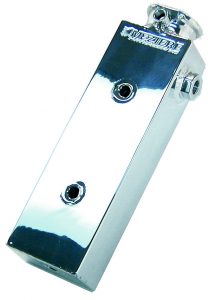
One of the big disadvantages in the old open type unpressurized system is that as the system cools, air is allowed back through the overflow tube. These systems are not totally filled with coolant because of the potential for coolant loss through the overflow tube when the coolant heats up and expands. As more coolant is lost through the overflow, sometimes into an overflow tank, less coolant is left to do its job within the engine. Because of this reduced capacity, and that air can enter the system and reduce cooling system efficiency, overheating can occur more easily. Closed reservoir systems were first used by car manufacturers in the early 1970’s.
COOLANT and COOLANT ADDITIVES
The Radiator Cap
- A top shell with two ears for engagement with the filler neck cams
- A spring disc diaphragm (and upper sealing gasket) to seal against the top of the filler neck and to provide friction to hold the cap on the neck
- A stainless steel pressure valve spring and pressure valve to seal against the bottom sealing seat of the filler neck
- Centered in the pressure valve is a vacuum relief valve (some are normally closed, while others are in a weighted-open position).
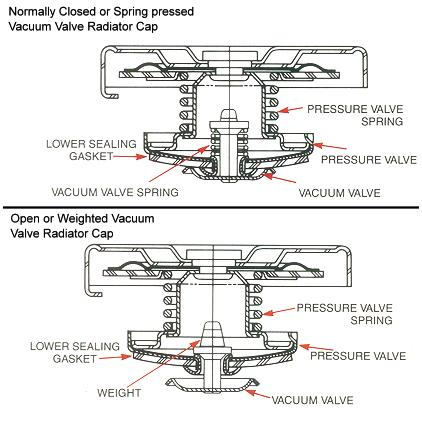
The Thermostat
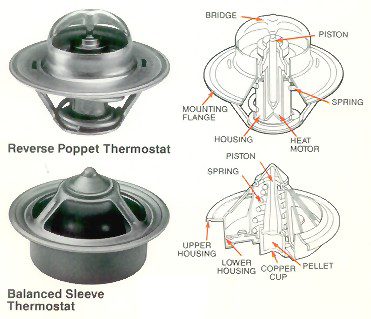
The Water Outlet
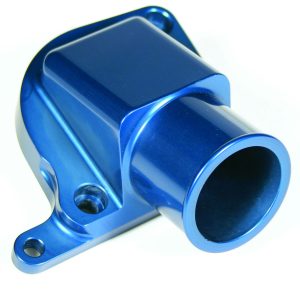
The water outlet on the engine is the connection point between the engine and the upper radiator hose which passes hot coolant to the radiator. The water outlet typically covers and seals the thermostat, and in some cases includes a thermostat bypass. Most water outlets are made from cast iron, cast aluminum, or stamped steel. If you decide to install a chrome water outlet, make sure you use one with a machined-in groove for a sealing o-ring. Otherwise, the smooth chrome facing on the water outlet will not allow proper sealing and leaks will occur. It is actually better to utilize an aftermarket anodized billet aluminum, or a cast iron version (when available). These offer the best overall sealing. If all you have is a stamped steel or cast aluminum housing, you will just have to make do and expect periodic leaks that will need to be repaired by gasket replacement or sometimes replacing the water outlet itself.
NOTE: Cast iron and anodized billet aluminum are the best at resisting corrosion from the coolant and natural mineral deposits created in the cooling system. One of the most common leaks is caused by over-tightening, or uneven tightening of the water outlet mounting bolts. Being careful to correctly tighten the mounting bolts is the best way to prevent this.
The Radiator
- The basic design of the radiator (core thickness, number of rows, tank capacity)
- The area and thickness of the radiator core that is exposed to cooling airflow
- The amount of cooling air that is able to pass through
- The difference between the temperature of the coolant and the temperature of the cooling air
- Manual or automatic transmission (if automatic is the trans cooler radiator-integrated or separate?)
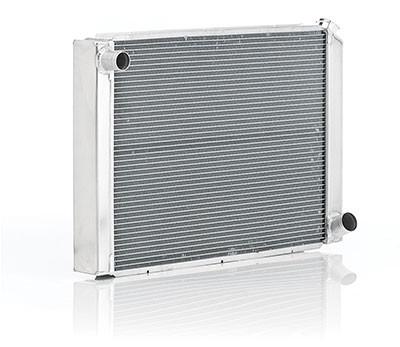
Hose (Coolant Lines) and Hose Clamps (Fittings)
The Water Pump
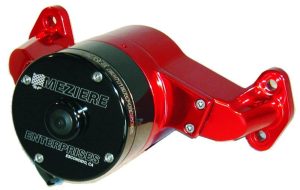
- An overtightened drive belt, causing side-loading on the pump shaft
- Contaminants in the cooling system allowing components to rust and corrode
- Excess air in the system, amplifying corrosion
- Failure of another component that internally damaged the pump (lower radiator hose spring, thermostat)
- Overall weight reduction (considering belts, pulleys)
- Higher flow levels
- Increased performance (no wasted horsepower to drive the pump)
- Between round cooling and faster cool-down (engine does not need to be running to circulate coolant)
- Increased (and higher static) flow at all RPM levels, to the limits of the pump
- Long life (corrosion-free)
- Excellent looks from a hard-anodized or polished finish
- Ensure your vehicle’s electrical system is compatible (adequate amperage and voltage, proper grounding, relays to guarantee power delivery to each electrical component)
- Electric fan(s) to replace a mechanical fan (if originally equipped)
- Redesign or rearrange pulley and accessory drive system
THE MECHANICAL RADIATOR FAN and FAN CLUTCH
A) Cold Testing: Grasp the fan blades as described above and spin the fan. It should spin, but there should be some resistance. If it is so loose you can spin it like a top and it keeps going it is defective. Now check the front-to-back lateral play. You may feel a considerable amount to the point of being clunky or popping. If so, the fan clutch must be replaced.
B) Operating Temperature Testing: Grasp the fan blades and you should feel firm resistance, but the fan will still spin, but not freely. If it spins freely and there has been no change between cold and warmed testing, replace the clutch.
The Electric Fan

Most new vehicles take advantage of electrical cooling fans as original equipment because of their smaller engine compartments and greater airflow demands. Mechanical fans are still common to pickups, SUVs, motorhomes, and other heavy duty applications. It is well known that an engine can cool itself as air passes through the radiator (no fan required) at cruising speeds of roughly 60 miles per hour in an average climate. Yet, with tighter under hood tolerances, unleaded fuels, higher combustion temperatures, forward mounted catalytic converters, and other heat-creating components and issues, a sole mechanical fan is not only impractical, but inefficient. In many modern vehicle applications the “60 mph cruising speed” example will not work, because some modern vehicle nose and engine bay designs simply do not have the natural airflow past the radiator available without some sort of fan in place and operating.
The Transmission Cooler
Have questions regarding this information?
Or, call our dedicated support staff at (775) 746-4887
Links to additional helpful tech articles

